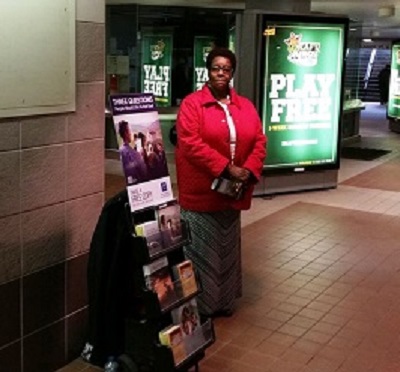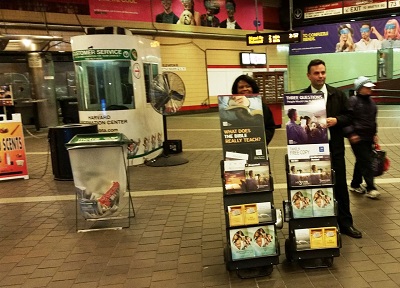An original SPI news article
by Deanna Cantrell
 Within BostonÔÇÖs subway system, called the MBTA, it is illegal to panhandle, peddle, or pass out flyersÔǪ Unless it is religion that you are peddling.┬á A lawsuit filed by Jews For Jesus, Inc. in 1993 overturned the law prohibiting leafleting within the subway system.┬á Allowing religious organizations to set up shop in the closed confines of a subway not only forces patrons to endure unsolicited contact from these organizations, but it also results in a potential threat to public safety, noise pollution, and litter.
Within BostonÔÇÖs subway system, called the MBTA, it is illegal to panhandle, peddle, or pass out flyersÔǪ Unless it is religion that you are peddling.┬á A lawsuit filed by Jews For Jesus, Inc. in 1993 overturned the law prohibiting leafleting within the subway system.┬á Allowing religious organizations to set up shop in the closed confines of a subway not only forces patrons to endure unsolicited contact from these organizations, but it also results in a potential threat to public safety, noise pollution, and litter.
There are now a total of 51 stations in the MBTA making up the subway system, with 4 main hub/transfer stations.┬á According to a study conducted in 2013, on any given day the MBTA services 766,924 people via subway.┬á Each station contains 2 ÔÇ£zonesÔÇØ, free and paid; the free zone consists of any area before a turnstile, and paid areas are all areas which are accessible to patrons after crossing the turnstile where fare has been paid.
The issue at hand, is that greeting and the passing out of literature by religious organizations is considered noncommercial expressive activity.  Such activity was found to cover the following: conducting any of the following activities for political or non-profit purposes; solicitation of signatures; distribution of printed materials; handshaking or greeting individual transit patrons or members of the public; or publicly addressing transit patrons at a noise level greater than 85 decibels.  Such activities were determined to be protected by the first amendment.  Organizations do not have to obtain prior consent from the Transit Authority in order to practice proselytizing, they just simply show up and set up shop.  Many bring rolling carts and stands for their material.  This serves to further congest and already busy area, impairing the flow of traffic.
The district court voided the authorization requirement as an unconstitutional prior restraint. It explained that the MBTA could not require a license to engage in ordinary speech like handshaking or greeting and that the authorization requirement did not promote the Authority’s avowed interests in public safety and evenhanded access to the subway stations for First Amendment activities.
As stated within the suit:
the Supreme Court has dismissed the danger to traffic congestion as a justification to ban leafleting. The Court has explained that “the distribution of literature does not require that the recipient stop in order to receive the message the speaker wishes to convey.”┬áISKCON, 112 S. Ct. at 2713-14 (O’Connor, J., Concurring) (quoting┬áKokinda, 110 S. Ct. at 3123). Bottlenecks, therefore, are unlikely to develop. Because leafletting is a particularly unobtrusive form of expression, the Court recently invalidated a ban on leafletting, even within a nonpublic forum.┬á This may be true if organizations merely handed out their single leaflet without stopping anyone, but if anyone stops this impedes the flow of traffic within these confined spaces.
The Fernandes v. Limmer court found that the interest in keeping terminal traffic freely flowing “is not sufficiently  compelling to justify the total exclusion of those wishing to exercise free speech and freedom of religion within the terminals.
compelling to justify the total exclusion of those wishing to exercise free speech and freedom of religion within the terminals.
The MBTA argued that by disrupting passenger flow opens up the window of opportunity for crime.  When a passenger pauses to speak with a member of a religious organization greeting and handing out literature, the congestion that this creates poses a danger for pick-pocketing.  A passenger is engaged in conversation and not actively aware of surroundings and belongings, this could easily pose a risk for such theft.  However, the court found that this risk is not a substantial enough cause to ban such activity.
The lawsuit also dismissed existing noise restrictions.  Previously restrictions were 85 decibels, even 85 decibels sustained over a prolonged period of time can produce hearing damage.  For reference, 85 decibels is the same noise level of a bulldozer.
According to the Centers for Disease Control, noise-induced hearing loss can result from a one-time exposure to a very loud sound (at or above 120 decibels), blast, impulse, or by listening to loud sounds (at or above 85 decibels) over an extended period. The louder the sound, the shorter the time period before hearing damage occurs.
Finally, leafleting was argued to lead to an increase in litter.┬á This was found by the court to be the fault of the litterer, not the organization leafleting.┬á Granted, it is an individualÔÇÖs responsibility to adhere to laws, this includes disposing of unwanted materials properly.┬á This is great in theory; however litter bugs still abound.
So, if you are a part of a religious organization what rules do you have to abide by in the Boston subway?┬á Remain 15 feet away from the platformÔÇÖs edge, as well as any structures such as doors, elevators and turnstiles, and do not leave your materials unattended.┬á Sounds like a small price to pay to have a captive audience of thousands.
